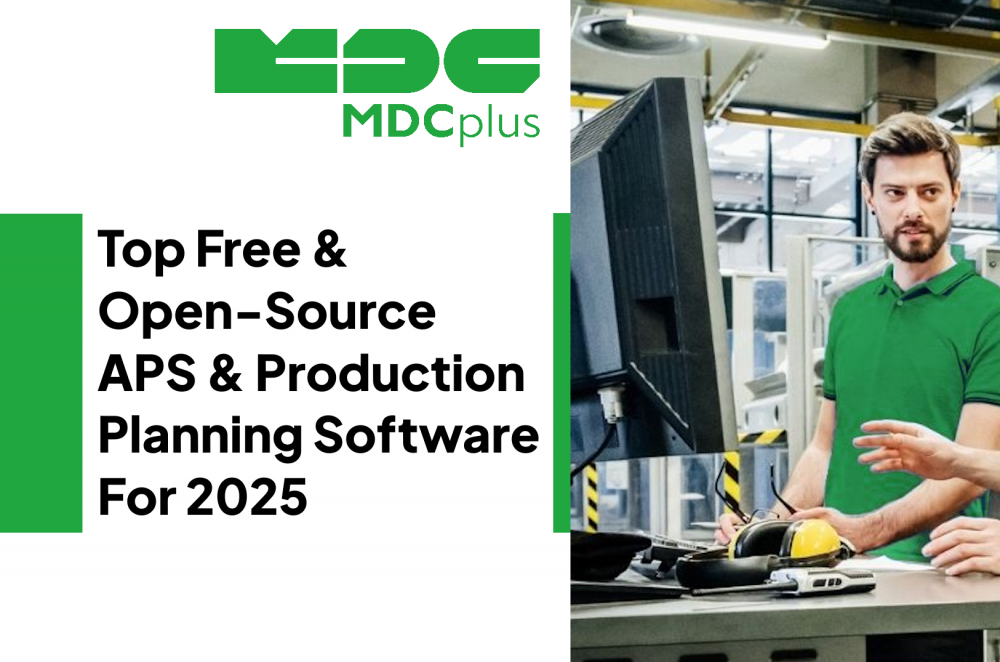Top Free & Open-Source APS & Production Planning Software for 2025
Advanced Planning and Scheduling (APS) systems help manufacturers align production resources, inventory, and capacity with actual demand. In 2025, open-source planning tools have matured enough to offer real alternatives to proprietary APS suites. They enable factories to model capacity constraints, simulate scenarios, and optimize work orders — all without high licensing costs.
1. frePPLe
Best for: manufacturers seeking a pure APS solution with real constraint-based planning. frePPLe is the most recognized open-source APS tool, built specifically for production planning and finite scheduling. It supports multi-level BOMs, material and capacity planning, and integrates easily with ERP systems via REST API. Commercial hosting and enterprise support are available but the Community Edition is fully functional.
2. ERPNext (Manufacturing Module)
Best for: SMEs needing integrated ERP + production planning. ERPNext includes production scheduling, BOM tracking, and work order management inside a single ERP platform. It’s Python-based and web-deployable, with solid documentation and an active community. While not a specialized APS, it provides enough flexibility for small to mid-size manufacturing environments.
3. OptaPlanner
Best for: custom constraint-based scheduling for factories with unique routing rules. OptaPlanner (by Red Hat) is an open-source optimization engine that can solve complex scheduling problems: job-shop, resource-constrained, workforce, or machine allocation. It’s a framework, not a ready-to-use app, but it can power in-house APS modules when combined with MES or ERP.
4. PyJobShop
Best for: research and integration-oriented teams needing open scheduling algorithms. PyJobShop is a lightweight Python library for production scheduling based on job-shop models. It can be integrated with pandas, PostgreSQL, or MES backends to simulate or optimize production flow.
5. Asprova Open (Community Projects)
Best for: hybrid manufacturing simulation and scheduling. Although Asprova’s main APS is commercial, several open forks and teaching versions circulate under MIT-like licenses, focusing on constraint scheduling and Gantt visualization. Suitable for experimentation and education.
6. Odoo (Manufacturing + MRP)
Best for: production planning inside a modular ERP stack. Odoo’s open-source Community Edition includes MRP and production scheduling modules that can form a basic APS workflow. It supports work-center management, routing, and Gantt-based planning. With OCA add-ons, it can scale to mid-size factories.
7. Axelor Open Suite
Best for: configurable business process management with built-in production scheduling. Axelor is an open-source ERP/BPM suite with manufacturing and APS components. Its architecture allows you to model complex workflows, resource allocation, and capacity control without heavy customization.
8. OpenPro ERP
Best for: organizations seeking simple master scheduling with resource balancing. OpenPro includes MRP, master production scheduling, and resource allocation modules. It’s older and less community-driven but can still serve as a lightweight planning tool for small factories.
9. PlanVisor (GitHub project)
Best for: academic and prototype-level production optimization. An emerging open-source tool for finite scheduling and resource balancing, PlanVisor provides visualization and rule-based planning for job-shop scenarios. While still early-stage, it’s promising for developers exploring APS algorithmics.
10. FrappeGantt + Custom Scheduler
Best for: teams building custom APS interfaces. FrappeGantt is an open-source Gantt component often used with ERPNext or MES dashboards. When combined with scheduling logic (Python/JS backend), it becomes a fully functional visual APS layer. Ideal for lean custom deployments.
Comparison Table
| Platform | Type | License | Key Focus | Community Activity | Complexity |
|---|---|---|---|---|---|
| frePPLe | APS | AGPLv3 | Finite capacity planning | High | Medium |
| ERPNext | ERP + Planning | GPLv3 | Integrated MRP/Production | High | Low |
| OptaPlanner | Framework | Apache 2.0 | Constraint-based scheduling | Very High | High |
| PyJobShop | Library | MIT | Research & custom integration | Medium | High |
| Asprova Open forks | Learning / experimental | MIT | Simulation + scheduling | Low | Medium |
| Odoo CE | ERP + MRP | LGPLv3 | Modular planning | Very High | Low |
| Axelor | ERP/BPM | AGPLv3 | Workflow + scheduling | Medium | Medium |
| OpenPro | ERP | Proprietary open | Basic scheduling | Low | Low |
| PlanVisor | Prototype | MIT | Finite scheduling | Low | Medium |
| FrappeGantt | UI component | MIT | Gantt-based visualization | High | Medium |
Recommendations
For industrial-grade APS, frePPLe remains the strongest open-source choice in 2025. It offers constraint-based planning, multi-site support, and active development.
For integrated ERP + scheduling, ERPNext and Odoo CE are the most pragmatic — easy to deploy, visually clear, and backed by large communities.
If your team prefers custom or algorithmic approaches, combine OptaPlanner or PyJobShop with your MES or data pipeline. This gives full control over constraints, optimization rules, and shop-floor logic.
For experimentation or educational projects, Axelor and PlanVisor are worth testing — especially for visual planning prototypes.
Conclusion
Open-source APS tools have matured from academic prototypes into serious industrial options. While none offer turnkey perfection, they enable manufacturers to design planning systems that reflect their real production constraints — not generic templates. The best path is modular: combine a planning engine (frePPLe or OptaPlanner) with execution data from MES (like MDCplus) and visualization via Grafana or FrappeGantt for a complete, cost-efficient digital scheduling ecosystem.
About MDCplus
Our key features are real-time machine monitoring for swift issue resolution, power consumption tracking to promote sustainability, computerized maintenance management to reduce downtime, and vibration diagnostics for predictive maintenance. MDCplus's solutions are tailored for diverse industries, including aerospace, automotive, precision machining, and heavy industry. By delivering actionable insights and fostering seamless integration, we empower manufacturers to boost Overall Equipment Effectiveness (OEE), reduce operational costs, and achieve sustainable growth along with future planning.
Ready to increase your OEE, get clearer vision of your shop floor, and predict sustainably?
